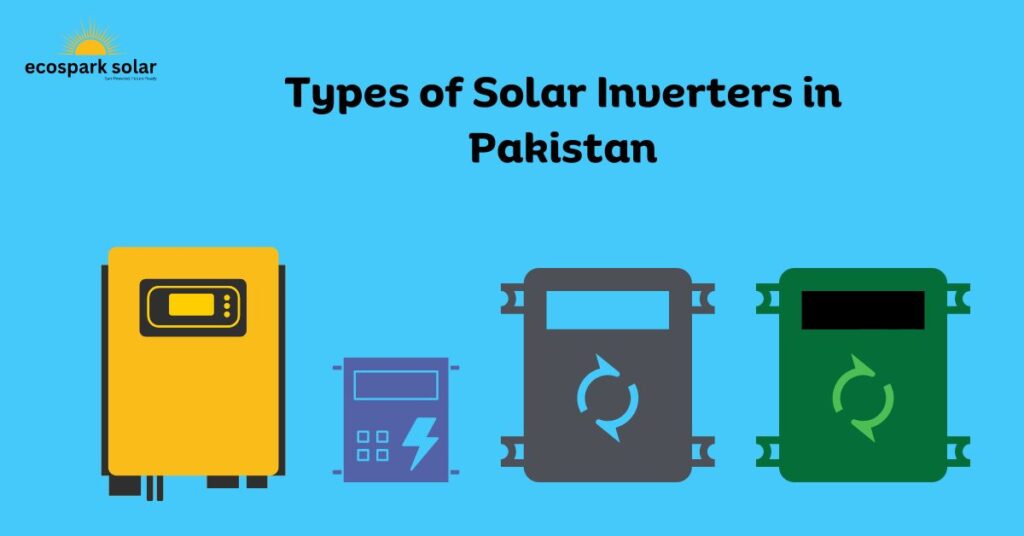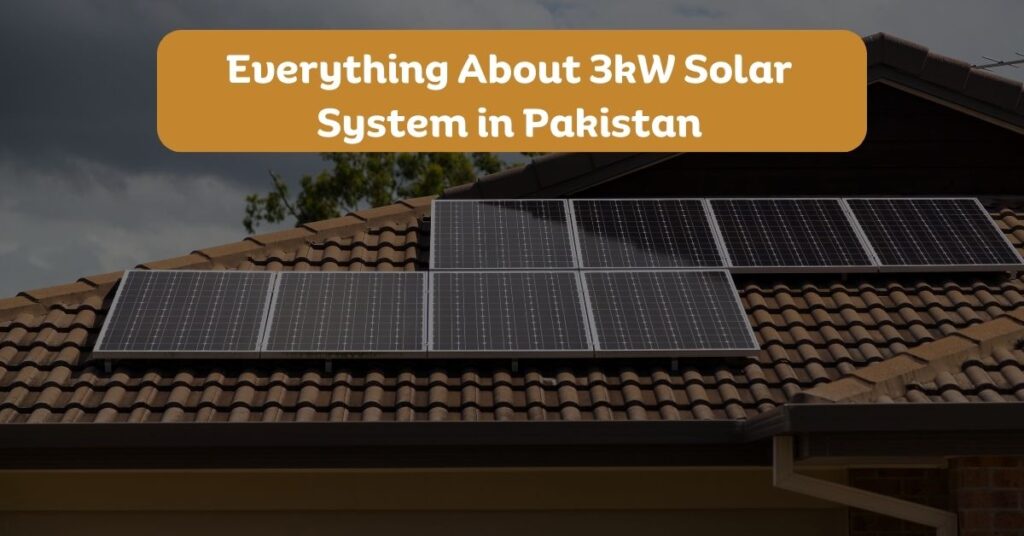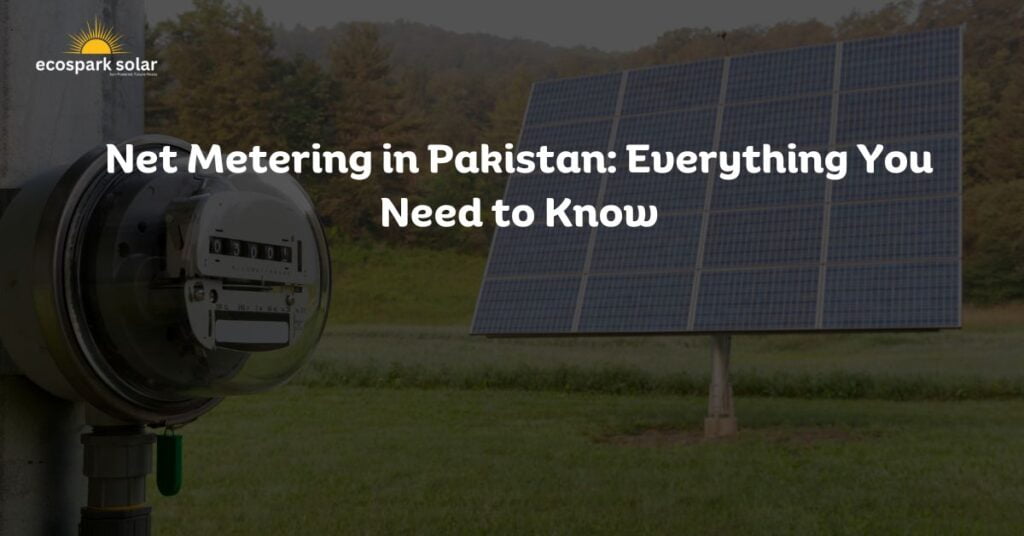Solar power offers a clean and renewable source of energy. But the electricity generated by solar panels is in the form of direct current (DC), which is different from the alternating current (AC) commonly used in our homes and offices.
So, how do we utilize the power generated by solar panels?
The answer lies in solar inverters. Solar inverters play a very important role in the solar energy system—I tend to call them the brain of solar power systems. They convert the DC electricity produced by solar panels into AC electricity, making it compatible with our existing electrical infrastructure.
In this article, we will explore the world of solar inverters available in Pakistan. We will delve into the various types of solar inverters based on their technology and application.
In brief, we will discuss the following:
- How does a solar inverter work?
- Types of solar inverters based on technology (such as central inverters, microinverters, etc.)
- Types of solar inverters based on application (such as grid-tie inverters, hybrid solar inverters, and off-grid inverters)
- How to choose the right solar inverter in Pakistan?
How Does a Solar Inverter Work?
Solar inverters convert the direct current (DC) electricity generated by solar panels into alternating current (AC) electricity, which is the type of electricity supplied by WAPDA to our homes and offices. But they don’t just convert DC into AC.
They also optimize the power output of the solar panels, synchronize the AC power with the electrical grid, and incorporate safety features to protect the system and ensure efficient operation. They serve as the intermediary between solar panels and electrical devices. In essence, they enable us to utilize solar energy for powering household appliances and lighting, making solar power accessible and practical for everyday use.
Types of Solar Inverters Based on Technology
Many types of solar inverters are available in the market based on their underlying technology. In Pakistan, however, only string inverters are most commonly used. Understanding the different types of solar inverters based on technology allows you to choose the most suitable option for your specific installation, considering factors such as shading, system size, budget, and expansion plans.
Let’s get to understand each type and how they differ from one another.
1. String Inverters

String inverters are the most common type of solar inverters used in residential and commercial installations. Almost any inverter that you come across in Pakistan will most likely be a string inverter.
They connect multiple solar panels in a series, form a string, and convert the combined DC power into AC power. This inverter is often installed close to the main electrical box of your home.
| Advantages | Disadvantages |
| Cost-effective and widely available in Pakistan | Vulnerable to shading issues, as the performance of the entire string is affected if one panel is shaded |
| Simple installation and maintenance | The performance of the entire string is limited by the weakest panel |
| High efficiency for larger installations | Lower energy production in partially shaded or mismatched systems |
2. Micro Inverters
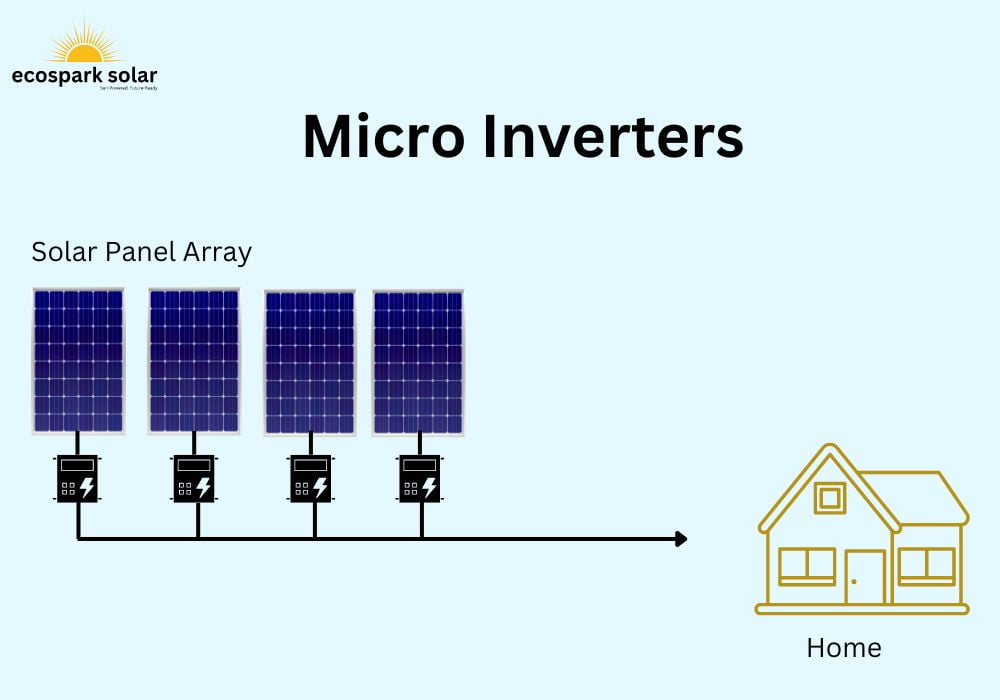
Microinverters are installed on each individual solar panel—they convert the DC power into AC power at the panel level. Each micro inverter operates independently, allowing for better system performance in shading or mismatched conditions. AC from each micro inverter is fed to the main electrical box, from where it flows to the home—or your business site.
| Advantages | Disadvantages |
| Enhanced system performance in shading or mismatched scenarios | Higher upfront cost compared to string inverters |
| Easy monitoring of individual panel performance | More complex installation and maintenance, as inverters are attached to each panel on the rooftop |
| Increased flexibility in system design and expansion | Lower efficiency for larger installations due to increased component count |
3. Power Optimizers + String Inverter
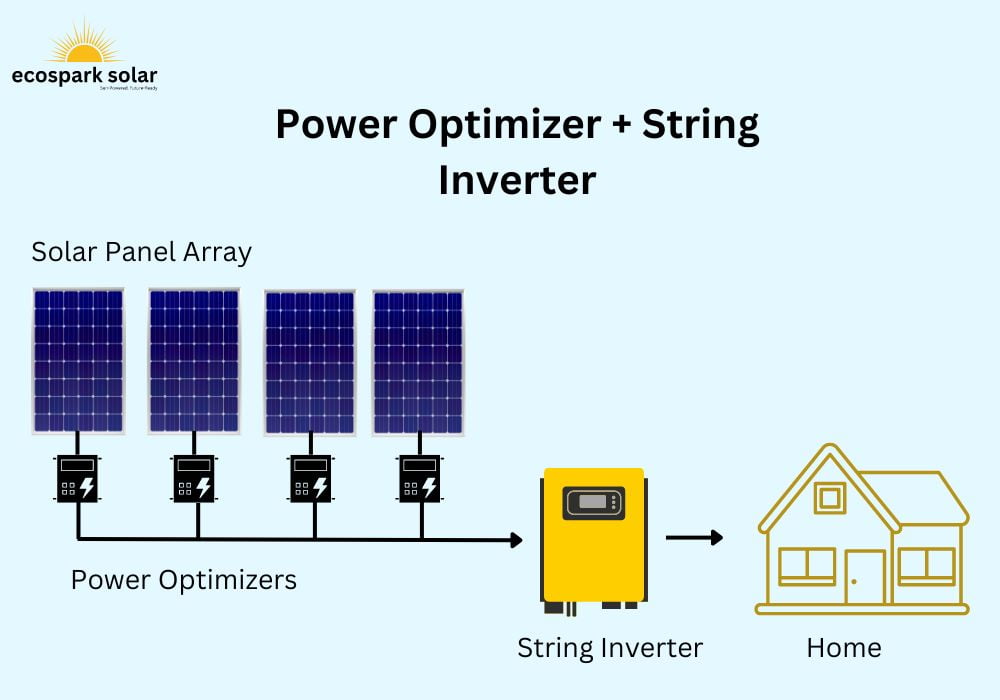
Power optimizers are also installed at the module level, similar to microinverters, but they perform DC-to-DC voltage optimization before the power is converted into AC by a central inverter. They maximize the energy output of each panel and allow for individual panel monitoring.
As you see, power optimizers are not as such inverters. They just work with inverters to enhance the performance of the solar panel system.
| Advantages | Disadvantages |
| Improved energy harvest in shading or mismatched conditions | Higher upfront cost compared to string inverters |
| Panel-level monitoring and performance optimization | Additional components increase installation complexity |
| Flexibility in system design and expansion | Efficiency can be affected by temperature and environmental factors |
Now, coming to types of inverters based on application and their suitability for different types of solar systems.
Types of Solar Inverters Based on Application
In this section, we have three types of solar inverters available to Pakistan solar owners:
- On-grid solar inverters
- Hybrid solar inverters
- Off-grid solar inverters
1. On-Grid Solar Inverters
On-grid inverters, also known as grid-tied inverters, are for grid-tie systems only. They are designed to work in conjunction with the electrical grid.
Grid-tie inverters convert the DC power generated by solar panels into AC power and synchronize it with the utility grid. This allows for the direct use of solar electricity in the building, while any excess power can be fed back into the grid for credits or compensation through net metering programs. And yes, we have a decent net metering mechanism in Pakistan.
| Advantages | Disadvantages |
| Utilize solar power while still having access to grid electricity | Dependence on the grid; no power during grid outages |
| Potential for earning credits or compensation through net metering | Compliance with utility regulations and interconnection requirements |
| Simplicity in system design and installation |
2. Hybrid Solar Inverters
Hybrid inverters are to be connected only with hybrid solar systems. As their name suggests, they provide a hybrid solution by combining solar power with energy batteries. They can manage both the solar panel inputs and the battery storage, allowing for optimal utilization of solar energy, backup power during outages, and the ability to store excess solar energy for later use.
An added benefit of hybrid inverters is that they can interact both with the grid and batteries. So, even If there is load shedding, thanks to hybrid inverters, you will have access to power.
| Advantages | Disadvantages |
| Ability to use solar power even during grid outages | Higher upfront cost due to the inclusion of battery storage |
| Energy independence and self-consumption optimization | Additional complexity in system design, installation, and maintenance |
| Potential for peak load management and reduced electricity bills | Battery lifespan and replacement considerations |
A solar system for everyone.
We’re customer-centric; we will find you a solution within your budget. Whatever your project size, you can always save with Ecospark Solar.
3. Off-Grid Solar Inverters
Off-grid inverters, also known as standalone inverters, are designed for systems that operate independently of the utility grid. So, they will work only with off-grid solar systems.
They convert the DC power generated by solar panels into AC power for immediate use or storage in a battery bank. Off-grid inverters are commonly used in remote locations or for powering off-grid applications such as cabins, boats, or recreational vehicles (RVs).
| Advantages | Disadvantages |
| Complete energy independence from the grid | Higher upfront cost due to the inclusion of battery storage |
| Suitable for remote locations or areas with unreliable grid access | Additional complexity in system design, installation, and maintenance |
| Power availability, even in the absence of the grid | Battery lifespan and replacement considerations |
How To Choose the Right Solar Inverter in Pakistan?
Selecting an inverter that best meets your individual requirements can be a challenging but necessary part of designing a solar energy system. Solar inverters consume a chunk of your solar investment; if not chosen properly, it can affect the solar payback period of your syetem.
Below are some of the key points to keep in mind when making this important choice:
1. System Size and Capacity
Carefully consider the size and capacity of your solar system when selecting an inverter. Different inverters are equipped to manage different power outputs; make sure your chosen model can support maximum solar panel output.
For example, if you are to install a 5kW solar system, then make sure the inverter is capable of efficiently converting all the energy generated by your solar system. An undersized inverter won’t be able to convert all the energy.
2. Efficiency and Conversion Rate
When selecting a solar inverter, you must consider its efficiency and conversion rate. A higher conversion rate ensures more solar energy is turned into usable electricity, thus optimizing production while decreasing losses. In Pakistan, most solar inverters come with around 97-98% efficiency. But don’t just go for the label—talk to your solar installer and ensure that it would perform at its best in real-life conditions.
3. Durability and Warranty
Consider inverters from reputed manufacturers known for their quality and longevity. What is their estimated lifespan? Do they offer warranties? And if yes, what is covered in the warranty? Ask all these questions from your solar installer to avoid any inconvenience in the future.
4. Compatibility with Solar Panels and Battery Systems
Make sure the inverter fits with your solar panel specifications, including voltage and power requirements. For example, if you have installed a hybrid system and your inverter is on-grid, it won’t perform during load shedding—and may also not be compatible with your batteries.
Also, make sure it works with whatever battery technology you plan to incorporate into your system.
5. Cost and Budget Considerations
Consider both cost and budget when selecting an inverter. While finding an economical solution is necessary, avoid cutting quality or performance corners to save money. When making this investment decision, balance upfront cost with long-term benefits and evaluate the return on investment over its lifespan. Here are some insights into the price of solar inverters in Pakistan.
6. Monitoring and Control Features
Take into account any available monitoring and control features. Some inverters provide built-in monitoring systems which allow you to track the performance of your solar energy system, monitor energy production, identify any issues or faults quickly, and keep an eye out for problems promptly. If the inverter offers that, it will be easy for you.
7. Consult with Experts or Installers
Still cannot make a decision? Worry not. Speak to our solar energy experts. We are professional installers who can assess your requirements, perform site evaluations, and offer tailored advice regarding inverter options that best fit your solar energy system.
